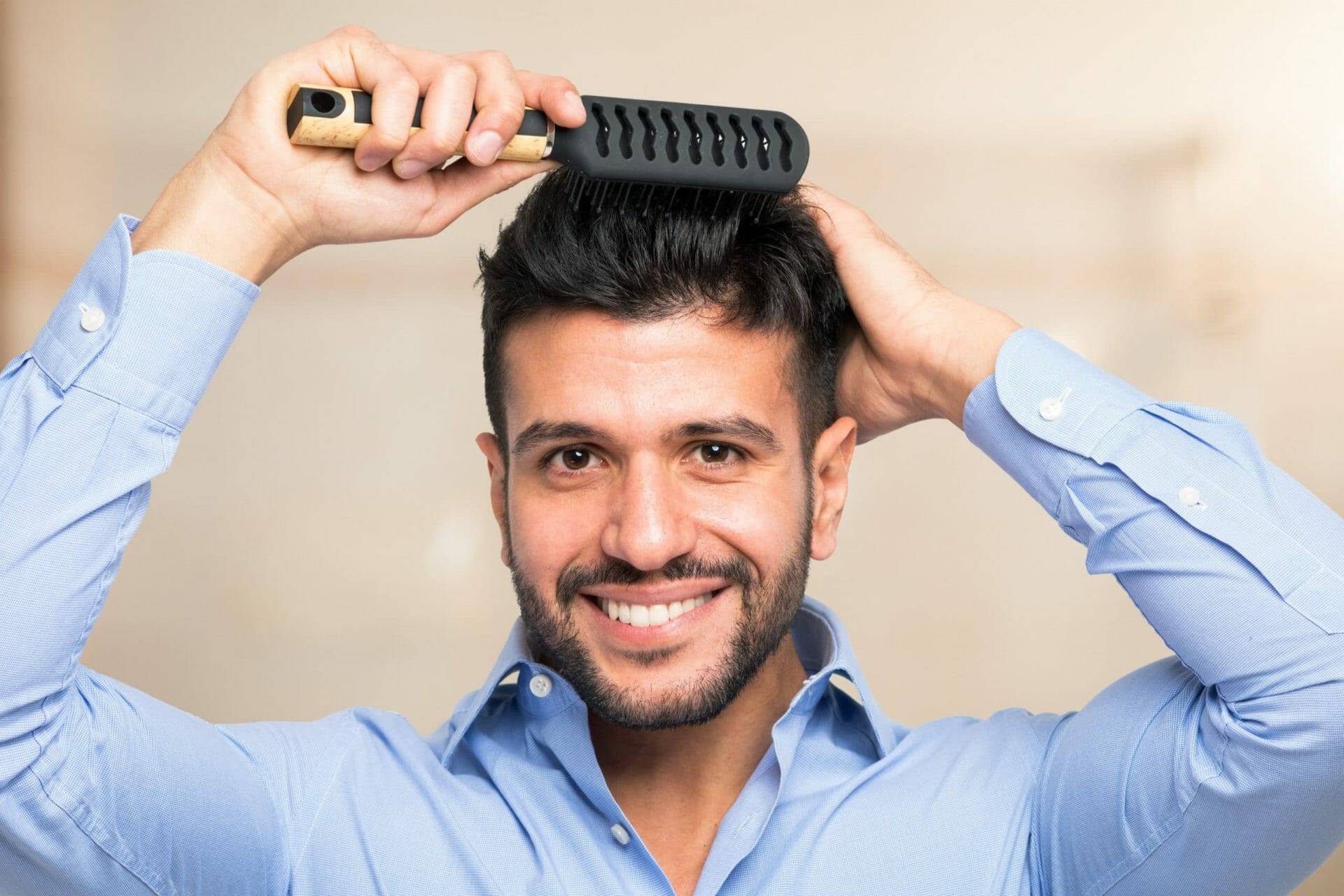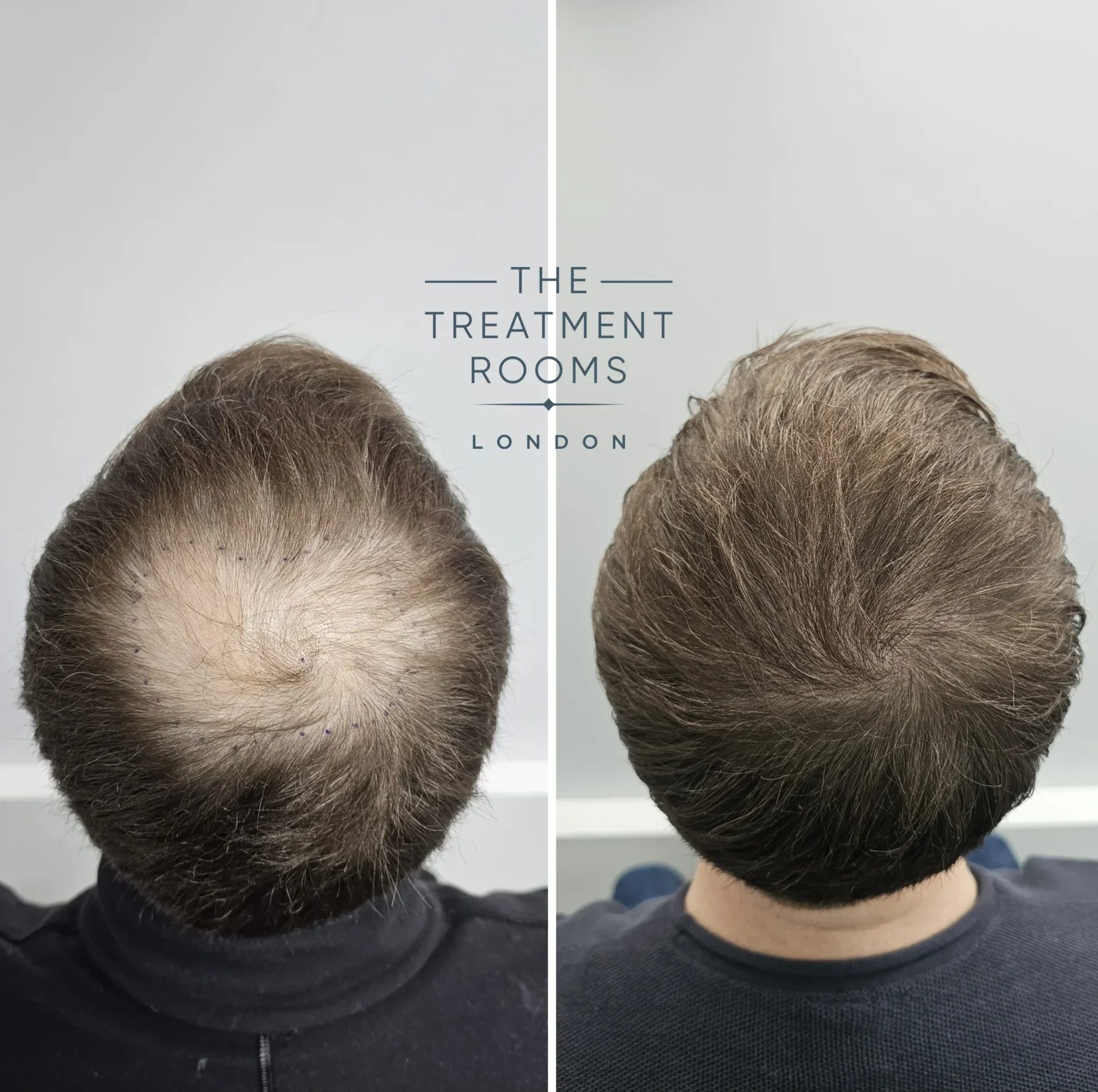Quick Summary: Microneedling After Your Hair Transplant – When Can You Start?
Hair transplants are life-changing procedures that can restore hair and confidence for individuals with hair loss. Although the surgery itself is a vital first step, post-operative care significantly influence the long-term success of the procedure.
One interesting post-transplant therapy is microneedling. Microneedling has gained recognition for its potential to promote hair regrowth, improve scalp health, and complement hair transplant results, [1] and we recommend patients who want to microneedle, wait until 3 months have passed following their surgery.
In this article, we will delve into the details of microneedling after hair transplants, including when it is safe to start, how it works, and the precautions you should take to protect your investment.
What Is Microneedling?
Microneedling (i.e., dermarolling) is a procedure that creates controlled micro-injuries in the skin with fine needles. These tiny punctures trigger the body’s natural healing process, which stimulates the production of collagen, keratin, and other growth factors.
In the context of hair health, microneedling improves blood circulation, promotes the absorption of topical treatments, and activates dormant hair follicles. This makes it a popular choice for individuals with mild- moderate cases of hair loss [2]. In those with severe, extensive hair loss such a Norwood 7 men, microneedling will have limited benefit as there is likely no dormant hair follicles.
Benefits of Microneedling For Hair And Scalp
Collagen Production – Strengthens the skin and scalp, which creates an optimal environment for hair growth. [3]
Improves Absorption – Enhances the effectiveness of topical treatments such as minoxidil since it allows them to penetrate deeper into the scalp. [3]
Follicular Activation – Upregulates dormant hair follicles to enter the growth phase. [3]
Increases Blood Flow – Supplies hair follicles with essential nutrients and oxygen. [3]
| Microneedling Benefits | Description |
| Boosts collagen production | Strengthens the scalp and supports hair regrowth. |
| Enhances topical treatment | Improves absorption of products like minoxidil for better results. |
| Stimulates follicular activity | Encourages hair follicles to transition into active growth. |
| Increases blood circulation | Delivers nutrients and oxygen essential for hair health. |
Microneedling and Hair Loss
Scientists have long established the benefits of microneedling when it comes to some hair loss conditions. You should think of this procedure as a complementary therapy for hair transplant and other treatments.
Androgenetic Alopecia (AGA)
Researchers found that the combination of microneedling with minoxidil significantly increases hair density compared to minoxidil alone in those suffering from androgenic alopecia (male pattern baldness or female pattern baldness). [4]
Alopecia Areata
Studies suggest that microneedling can modulate the immune response in the scalp, which makes it a viable option to treat autoimmune-related hair loss such as alopecia areata. [5]
Post-Transplant Regrowth
Microneedling supports the regrowth of transplanted hair as it improves follicle activity and scalp health.
Clinical Evidence For Microneedling
A study that involved 86 individuals found that those who combined microneedling with minoxidil experienced 50% more hair density than those who used minoxidil alone. [6]
In another study, researchers investigated patients with androgenic alopecia who failed to respond to conventional treatments. It found that participants reported a 50-75% improvement in hair thickness within six months of starting microneedling. [7]
Learn more about microneedling for hair loss by clicking here.
Where Can You Microneedle on the Scalp?
Microneedling can be performed on almost any part of the scalp to promote hair regrowth. However, you should follow some considerations after a hair transplant:
Transplanted Areas – Avoid microneedling on these areas until the scalp has fully healed (at least three months post-surgery).
Non-Transplanted Areas – Safe to start earlier, especially to prevent further hair loss or enhance the growth of native hair.
Safety Tips
- Always consult your surgeon before starting microneedling, especially on transplanted areas.
- Use sterilised devices to minimise the risk of infection.
How Deep Should You Microneedle?
The depth of microneedling is important to achieve results without unnecessary damage. For hair-related treatments, the recommended depth typically ranges from 0.5 mm to 1.5 mm.
| Needle Depth (mm) | Purpose | Recommended For |
| 0.5 | Improves absorption of topical treatments | Early-stage hair loss |
| 1.0 | Stimulates collagen and blood flow | Moderate hair thinning |
| 1.5 | Reaches deeper follicles | Severe thinning or post-transplant |
Does Microneedling Work?
Microneedling is not just a cosmetic trend. There is plenty of evidence to support its effectiveness. Studies have shown that microneedling enhances the absorption of hair growth treatments, stimulates follicle activity, and promotes new hair growth. [8]
Increases Hair Density – Patients who use microneedling in conjunction with minoxidil experienced significantly higher hair density within six months.
Improves Thickness – Post-transplant patients reported noticeable improvement in hair thickness after the incorporation of microneedling into their recovery.
When Can Microneedling Restart After a Hair Transplant?
Timing is absolutely critical when you incorporate microneedling into your post-transplant care. The procedure involves micro-injuries, which could harm transplanted grafts if performed too soon.
Here’s the recommended timeline:
0–3 Months – Avoid microneedling altogether. The scalp needs time to heal fully. Also, residual redness or irritation should subside.
After 3 Months – If the scalp shows no signs of redness or sensitivity, microneedling can be cautiously reintroduced.
5+ Months – Regular sessions can resume. Focus on transplanted areas to enhance hair density.
On a side note, you should always consult your hair transplant surgeon before you start microneedling post-surgery. Also, start with shallow depths (0.5 mm) and increase gradually based on scalp response.
Risks of Microneedling After a Hair Transplant
Although microneedling is generally safe, certain risks exist, especially if performed too soon after surgery:
Damaged Follicles – Premature microneedling can dislodge or damage newly transplanted follicles.
Prolonged Redness – Aggressive, repetitive treatment can exacerbate scalp redness and irritation.
Skin Irritation – The improper sterilisation of tools can cause infection of the scalp.
| Risks | Mitigation Strategies |
| Damage to new follicles | Wait at least three months before you start microneedling. |
| Prolonged irritation | Use gentle techniques and consult a professional for initial sessions. |
| Infection risk | Use sterilised and high-quality devices. Also, follow aftercare instructions. |
Best Practices for Microneedling After Hair Transplant
To maximize the benefits of microneedling, stick to these practices:
Consult a Specialist
Always seek guidance from your surgeon or a trained professional.
Use Medical-Grade Devices
High-quality tools ensure precision and reduce the risk of irritation or infection.
Start Slow
Begin with low needle depths and increase gradually based on your scalp’s tolerance.
Combine Therapies
Pair microneedling with treatments such as PRP (Platelet-Rich Plasma) or minoxidil.
Monitor Scalp Condition
If you notice prolonged redness or irritation, pause treatment and consult a professional.
Conclusion
Microneedling is a powerful tool in hair restoration. It provides an array of benefits such as enhanced growth and improved scalp health. However, its success depends on proper timing, technique, and adherence to safety protocols.
Make sure to wait at least three months after a hair transplant and consult with a professional to safely incorporate microneedling into your recovery plan and achieve optimal results.
References
1- Alster, T. S., & Graham, P. M. (2018). Microneedling: A Review and Practical Guide. Dermatologic surgery : official publication for American Society for Dermatologic Surgery [et al.], 44(3), 397–404. https://doi.org/10.1097/DSS.0000000000001248
2- Gupta, A. K., Quinlan, E. M., Venkataraman, M., & Bamimore, M. A. (2022). Microneedling for Hair Loss. Journal of cosmetic dermatology, 21(1), 108–117. https://doi.org/10.1111/jocd.14525
3- Fertig, R. M., Gamret, A. C., Cervantes, J., & Tosti, A. (2018). Microneedling for the treatment of hair loss?. Journal of the European Academy of Dermatology and Venereology : JEADV, 32(4), 564–569. https://doi.org/10.1111/jdv.14722
4- Dhurat, R., Sukesh, M., Avhad, G., Dandale, A., Pal, A., & Pund, P. (2013). A randomized evaluator blinded study of effect of microneedling in androgenetic alopecia: a pilot study. International journal of trichology, 5(1), 6–11. https://doi.org/10.4103/0974-7753.114700
5- Almutlq, M. M., & Bukhari, A. E. (2024). Growth Factors and Microneedling in Alopecia Areata: A Narrative Review. Skin appendage disorders, 10(2), 92–98. https://doi.org/10.1159/000534636
6- Kumar, M. K., Inamadar, A. C., & Palit, A. (2018). A Randomized Controlled, Single-Observer Blinded Study to Determine the Efficacy of Topical Minoxidil plus Microneedling versus Topical Minoxidil Alone in the Treatment of Androgenetic Alopecia. Journal of cutaneous and aesthetic surgery, 11(4), 211–216. https://doi.org/10.4103/JCAS.JCAS_130_17
7- Dhurat, R., & Mathapati, S. (2015). Response to Microneedling Treatment in Men with Androgenetic Alopecia Who Failed to Respond to Conventional Therapy. Indian journal of dermatology, 60(3), 260–263. https://doi.org/10.4103/0019-5154.156361
8- Kim, Y. S., Jeong, K. H., Kim, J. E., Woo, Y. J., Kim, B. J., & Kang, H. (2016). Repeated Microneedle Stimulation Induces Enhanced Hair Growth in a Murine Model. Annals of dermatology, 28(5), 586–592. https://doi.org/10.5021/ad.2016.28.5.586
Share:
Authored by
Reviewed by
Book a Consultation
Related Blogs
Best Post-Hair Transplant Medication for Effective Recovery and Growth
July 15, 2025
Hair transplant surgery has become one of the most effective and reliable methods for physically reversing hair…
10 Home Remedies for An Itchy Scalp That Actually Work (Backed by Science)
July 15, 2025
Having an itchy scalp is common for most people at some point in their lives. The itch…
Does an FUE Hair Transplant Leave Scars? Myths, Facts & What to Expect?
July 14, 2025
Does an FUE hair transplant leave scars? The short answer to this is yes. All current hair…
Female Pattern Baldness (Androgenetic Alopecia): Symptoms, Causes & Treatments
July 11, 2025
Female pattern baldness, also known as androgenetic alopecia, is a common genetic condition characterised by hair thinning…
What is DHT & Its Role in Hair Loss?
July 11, 2025
Hair loss is a common concern that millions, if not billions, of people experience at some point…
Complete Guide on Folic Acid and Hair Loss
July 9, 2025
Quick Summary Hair loss is a widespread concern that affects millions of people globally. While genetics, hormonal…
Does Hair Dye Cause Hair Thinning? Understanding the Risks and Facts
July 8, 2025
Have you noticed more hair loss after dyeing your hair? The ingredients in some dyes can be…
When Can You Safely Wear a Beanie After a Hair Transplant?
July 3, 2025
Quick Summary Cap Recommendations: Light, breathable caps, such as snapbacks or trucker hats, are advisable if you need…
Castor Oil (Ricino Oil) for Hair Growth: Benefits, Uses & How to Apply for Maximum Results
June 26, 2025
Castor oil, also known as Ricino oil, is extracted from the Castor bean plant (Ricinus communis). During…











